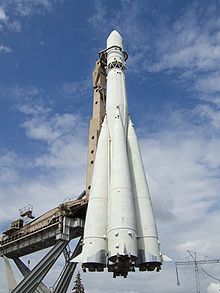
Back Восток (ракета) Bulgarian Vostok (coet) Catalan Vostok (nosná raketa) Czech Wostok (Rakete) German Vostok (cohete) Spanish Vostok-rakettiperhe Finnish Vostok (fusée) French ווסטוק (משגר) HE वोस्तोक (रॉकेट परिवार) HI Vostok Croatian
 Vostok 8K72K rocket on display in Moscow at the Exhibition of Achievements of National Economy | |
| Function | Carrier rocket |
|---|---|
| Manufacturer | RKK Energia |
| Country of origin | Soviet Union |
| Size | |
| Mass | 280,000–290,000 kg (620,000–640,000 lb) |
| Stages | 3 |
| Capacity | |
| Payload to LEO | |
| Mass | 4,725 kilograms (10,417 lb) |
| Associated rockets | |
| Family | R-7 |
| Comparable | Atlas Titan |
| Launch history | |
| Status | Retired |
| Launch sites | Baikonur: LC-1/5, 31/6 Plesetsk: LC-41/1, 43/3, 43/4 |
| Total launches | Vostok-L: 4 Vostok-K: 13 Vostok-2: 45 Vostok-2M: 94 Soyuz/Vostok: 2 |
| Success(es) | Vostok-L: 3 Vostok-K: 11 Vostok-2: 40 Vostok-2M: 92 Soyuz/Vostok: 2 |
| Failure(s) | Vostok-L: 1 Vostok-K: 2 Vostok-2: 5 Vostok-2M: 2 |
| First flight | 15 May 1960 (Vostok-L) |
| Last flight | 29 August 1991 (Vostok-2M) |
| Type of passengers/cargo | Vostok Zenit Meteor |
| First stage (Block B, V, G, D) | |
| Powered by | 1 RD-107-8D74-1959 |
| Maximum thrust | 970.86 kN |
| Burn time | 118 seconds |
| Propellant | Kerosene/LOX |
| Second stage (Block A) | |
| Powered by | 1 RD-108-8D75-1959 |
| Maximum thrust | 912 kN |
| Burn time | 301 seconds |
| Propellant | RP-1/LOX |
| Third stage (Block E) | |
| Powered by | 1 RD-0109 |
| Maximum thrust | 54.5 kN |
| Burn time | 365 seconds |
| Propellant | Kerosene/LOX |
Vostok (Russian: Восток, translated as "East") was a family of rockets derived from the Soviet R-7 Semyorka ICBM and was designed for the human spaceflight programme. This family of rockets launched the first artificial satellite (Sputnik 1) and the first crewed spacecraft (Vostok) in human history. It was a subset of the R-7 family of rockets.
On March 18, 1980, a Vostok-2M rocket exploded on its launch pad at Plesetsk during a fueling operation, killing 48 people. An investigation into a similar – but avoided – accident revealed that the substitution of lead-based for tin-based solder in hydrogen peroxide filters allowed the breakdown of the H2O2, thus causing the resultant explosion.